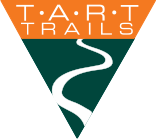TART Trails is a partner in the Grand Vision and a member of the Complete Streets Coalition. The Grand Vision clearly supports increased mobility and placemaking opportunities. Adopting complete streets, both through our policies and our practices, is a meaningful way to put Grand Vision into action. The Complete Streets page of the Grand Vision website provides additional information and resources. Please contact Julie Clark for information on how you can be more connected to this coalition of people, organizations and businesses. View the Complete Streets Initiative Report for Grand Traverse County here.
A local example of complete streets in action is the work of the City’s Active Transportation Committee, which is in the process of creating an Active Transportation Plan. The mission of the plan is: a community designed for healthy, active living that provides and promotes safe, inviting, efficient and inclusive access to public and private attractions regardless of age, physical ability, or choice of transportation. Visit the Active Transportation Committee page to learn more about the effort.
Check out the Complete Streets photo gallery by clicking here.
Complete Streets Infrastructure
Around Traverse City and throughout the County you might start seeing new and improved ways to make your way around town on two wheels or two feet. As the area becomes more bicycle and pedestrian friendly, you might see more bicycle lanes, contra-flow lanes, sharrows, crosswalks and even trails.
Bicycle Lanes
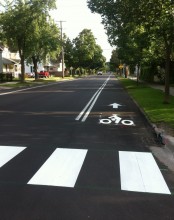
The US Department of Transportation Federal Highway Administration’s Manual on Uniform Traffic Control Devices (MUTCD) defines bike lanes as “a portion of the roadway which has been designated by striping, signing and pavement marking for the preferential or exclusive use by bicyclists.” In general, this designated lane helps many bicyclists feel more comfortable on a roadway and helps motorists expect to see cyclists and predict their movements.
Tips for using Bike Lanes:
Go with the flow: Unless delineated as such, bike lanes are not for two-way traffic. Do not ride against the flow of traffic. Doing so greatly increases your risk of a crash.
Door zone: If there is a bike lane adjacent to parked cars, avoid the door zone. Often someone getting out of their car will not check to see if a person on a bike is coming before opening their door. Ride defensively. If you are parking next to a bike lane, try opening your door with right hand, forcing you to reach over and look backward.
Intersections: The majority of conflict points are at the intersections and although a well designed bike lane can help make people on bikes more noticeable, it still can be tricky going crossing at an intersection. Again, be defensive, obey all traffic signals, and watch for turning vehicles both from ahead of you (a left turning vehicle) and coming from behind (a right turning vehicle).
No Bike lane or Taking that Turn: On many bike lanes, the bike lane is only present on part of the route. If no bike lane is present, or simply ends, checking for traffic, shift away from the curb to avoid debris and to make yourself more visible to other traffic. Similarly, if you are approaching an intersection in a bike lane and must make a left hand turn, you need to exit the bike lane and take the traffic lane to complete your left turn. Alternatively, you can make a “Copenhagen Left” as seen in the video below.
Streets for All: Be aware that a person on a bike typically has a right to use almost any street. A bike lane is an extra lane to help encourage cycling, provide safety, and to keep all traffic flowing well.
Know the Rules of the Road: Check out League of Michigan Bicyclists “What Every Michigan Bicyclist Must Know.“ You can also pick one up a printed copy at the TART office.
Click here to see a fun video about how to bike in the city.
Contra-flow Bicycle Lanes
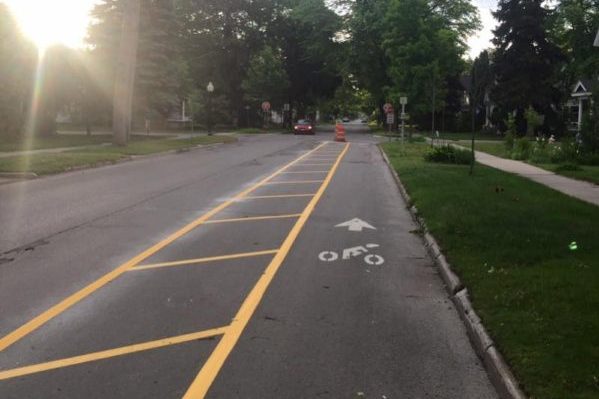
Contra-flow bicycle lanes are bicycle lanes designed to allow bicyclists to ride in the opposite direction of motor vehicle traffic. They convert a one-way traffic street into a two-way street: one direction for motor vehicles and bikes, and the other for bikes only. Contra-flow lanes are separated with yellow center lane striping. Combining both direction bicycle travel on one side of the street to accommodate contra-flow movement results in a two-way cycle track. Learn more about contra-flow lanes here.
A few examples of contra-flow lanes in Traverse City are on Seventh St. where it crosses Division St. and at the exit from the Civic Center onto Garfield Rd.
Sharrows
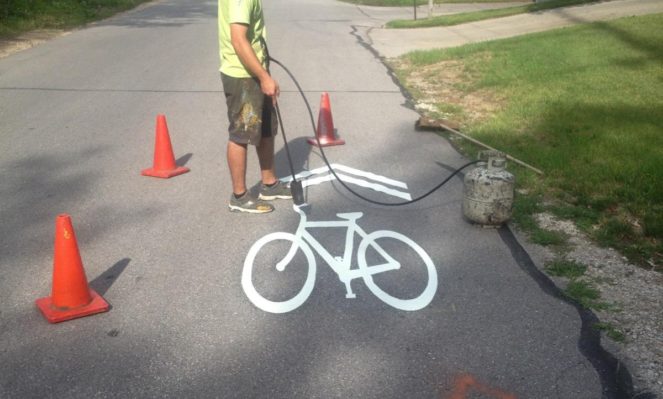
Where bike lanes may not fit, or aren’t appropriate, sharrows, or shared lane markings, are a tool that can be used. Sharrows are special pavement symbols that denote where a bicyclist should ride without a striped bike lane. Sharrows are a graphic way to advise motorists and bicyclists that they share a lane. Sharrows can also help position bicyclists safely away from hazards like door zones.
Follow the rules of the road and ride with confidence to be sure you’re safe and seen.
Traverse City’s Crosswalk Ordinance
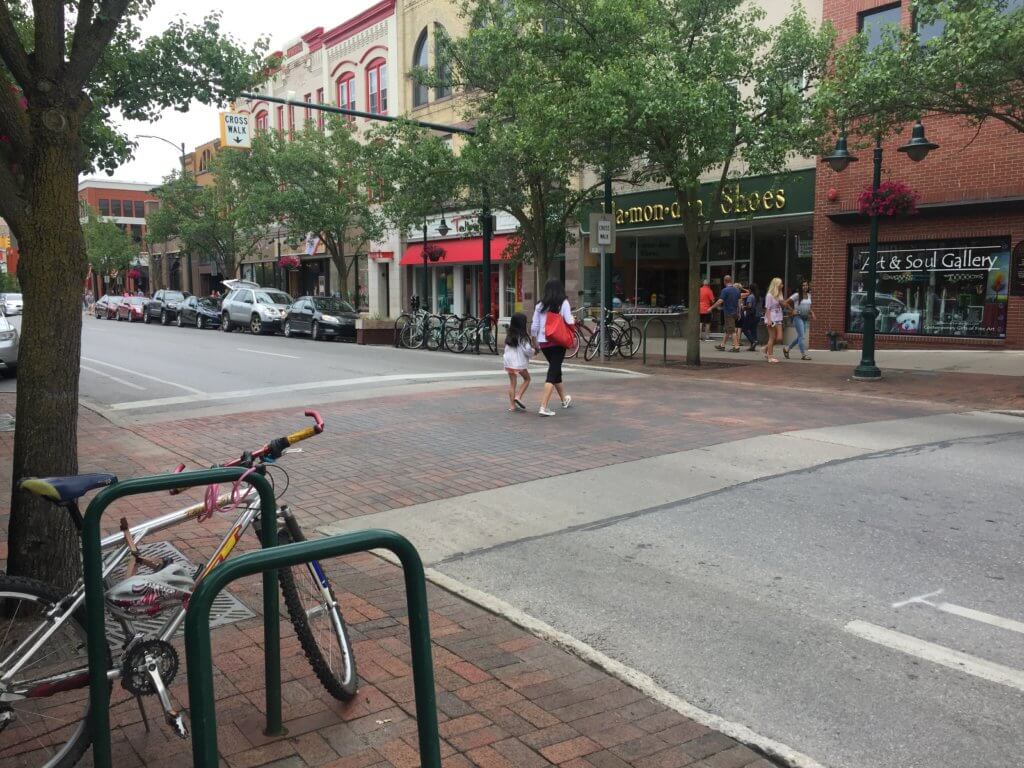
Pedestrians continue to gain ground in Traverse City, with many people traveling the city on-foot to get to their destinations, or simply choosing to walk as an enjoyable exercise option. In appreciation and support of Traverse City’s pedestrian culture, the City Commission added the ability for safety officers to issue a civil infraction to vehicle drivers who fail to stop for pedestrians in marked crosswalks.
Communities that have similar requirements to stop for pedestrians in marked crosswalks include, Ann Arbor, Michigan; and the entire states of Minnesota, Wisconsin, Kansas, New York, Colorado, Connecticut, Maryland, North Carolina, Florida, Nebraska, Minnesota, Washington, Oregon, Hawaii and Washington D.C. require drivers to stop for pedestrians in marked crosswalks.
Supporting pedestrian safety is a key component of the City’s Master Plan, the Transportation Element and the City’s complete streets policy, which supports a safe, walkable community for people choosing to walk to their destinations.
Trails
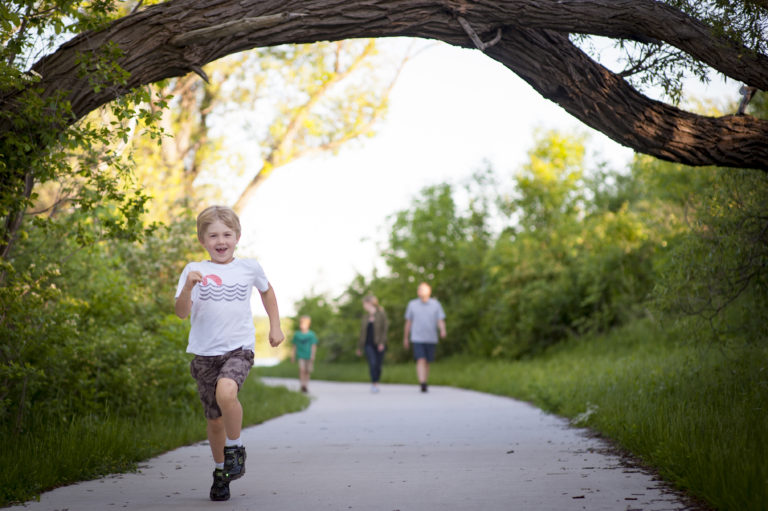
With over 100 miles of connected paved trails running through the region, multi-use paths or trails, are a great way to get around town. Trails in town accommodate many forms of non-motorized transportation, including running, walking and cycling.
Our trails in town accommodate two-way traffic. Remember to slow down, warn people as you approach from behind, and pass on the left. Respect all private property and obey traffic signs. Yes, those stop signs on the trail are meant for you. While there are no speed limit signs posted, remember that the trails are not your own personal drag strip. Be kind, be careful, have fun!
